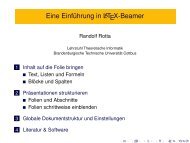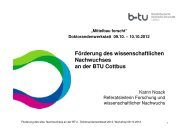Multilevel Graph Clustering with Density-Based Quality Measures
Multilevel Graph Clustering with Density-Based Quality Measures
Multilevel Graph Clustering with Density-Based Quality Measures
You also want an ePaper? Increase the reach of your titles
YUMPU automatically turns print PDFs into web optimized ePapers that Google loves.
3.3 Merge SelectorsExtent Name Descriptionlocal modularity increase highest increase of modularitylocal weight density highest density between both clusterssemi-global random walk distance (t) best neighborhood similarity<strong>with</strong> t random walk stepssemi-global random walk reachability (t,i) highest weight density <strong>with</strong> reachabilityof neighbor vertices as weight;<strong>with</strong> t steps and i iterationsglobal spectral length approx. best modularity contribution inspectral decompositionglobal spectral length difference approx. highest modularity increase inspectral decompositionglobal spectral angle most similar direction of the spectralvertex vectorsTable 3.1: Proposed Merge Selection QualitiesBoth aims are pursued by trying to predict which vertex pairs lie in the samecluster compared to the unknown optimum clustering. In this setting the selectionqualities are the predictors. Their prediction quality (success probability) can beroughly measured by comparing the initial ranking of pairs against the best knownclustering. The second aim may be fulfilled by proposing pairs well spread overthe graph and not concentrated in a single region. But other factors may be moreimportant, like for example the question when merge errors (merging vertices ofdifferent optimum clusters) occur during the coarsening. Ultimately the only reliablemeasure of success are the modularity clustering qualities reached after coarseningand after refinement.The presented selection qualities are classifiable by the extent of incorporatedinformation into local, semi-global, and global measures. Local measures use onlyinformation about the two adjacent vertices and their connecting edge. Semi-globalmeasures try to incorporate more information from the neighborhood of both verticesand global measures consider the topology of the whole graph at once.Non-local selectors can differ in how they are updated during merge steps. Dynamicallyupdated selectors recompute the selection qualities after each merge, whereasstatic selectors just use simple approximations on the intermediate coarse graphs.All presented selection qualities are static. The key properties are computed once atthe beginning of each coarsening pass. During single merge steps values are mergedand updated just locally.Table 3.1 summarizes the proposed selection qualities. They are discussed in moredetail in the following sections beginning <strong>with</strong> local selectors followed by randomwalks and spectral methods. Each of these sections is subdivided into a short introductionof the key ideas, presentation of the theoretical background and concludes<strong>with</strong> the discussion of derived selection qualities.33






